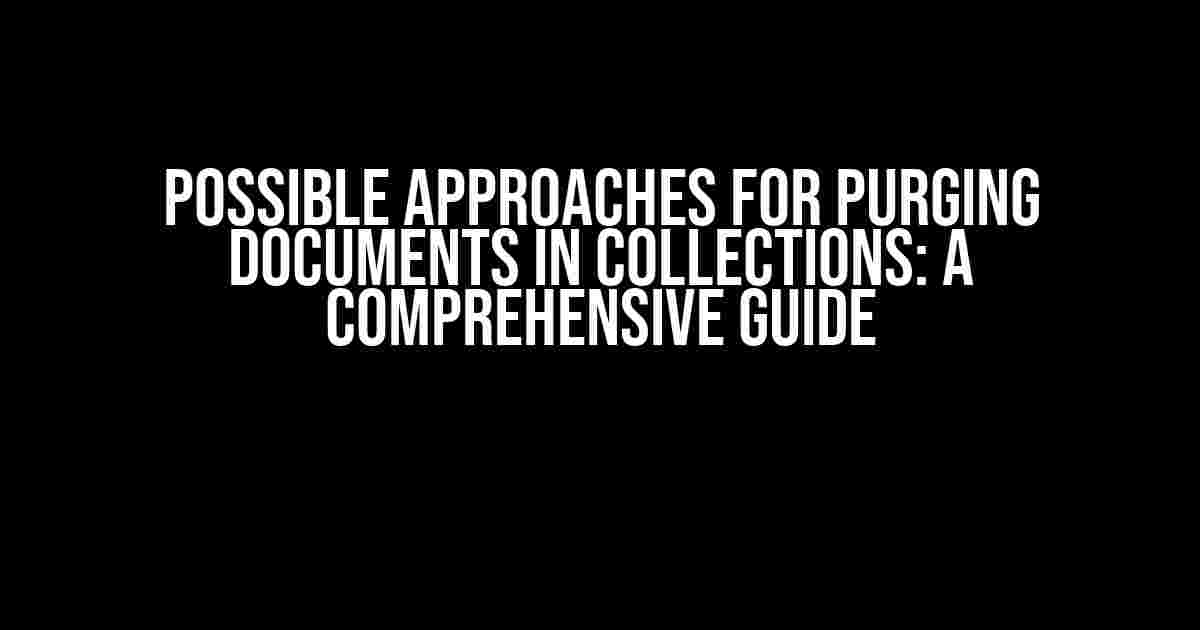Are you tired of dealing with massive collections of documents that are no longer needed? Do you struggle with finding an efficient way to purge them without compromising your data integrity? Fear not, dear reader, for we’ve got you covered! In this article, we’ll explore possible approaches for purging documents in collections, providing you with a comprehensive guide to streamline your data management.
Understanding the Importance of Purging Documents
Before we dive into the approaches, let’s discuss why purging documents is crucial for your collection’s health.
Having an enormous collection of documents can lead to:
- Increased storage costs
- Slow query performance
- Data inconsistencies and redundancy
- Difficulty in finding relevant information
- Security risks due to outdated or unnecessary data
Purging documents helps maintain a clean and organized collection, ensuring that your data remains relevant, accurate, and secure.
Approach 1: Date-Based Purging
This approach involves removing documents based on their creation or modification dates.
db.collection.deleteMany({ createdAt: { $lt: ISODate("2020-01-01T00:00:00.000Z") } })
This MongoDB command deletes all documents created before January 1st, 2020.
Pros:
- Simplistic and easy to implement
- Efficient for large collections
- Reduces storage costs
Cons:
- May delete important documents that are still relevant
- Does not consider document content or metadata
Approach 2: Metadata-Based Purging
This approach involves removing documents based on their metadata, such as keywords, categories, or tags.
db.collection.deleteMany({ categories: "outdated-category" })
This MongoDB command deletes all documents with the category “outdated-category”.
Pros:
- Allows for more granular control over document removal
- Can be used in conjunction with date-based purging
- Helps maintain data consistency
Cons:
- Requires accurate and consistent metadata
- Can be time-consuming for large collections
Approach 3: Content-Based Purging
This approach involves removing documents based on their content, such as specific words, phrases, or patterns.
db.collection.deleteMany({ content: /regex-pattern/ })
This MongoDB command deletes all documents containing the regex pattern.
Pros:
- Allows for precise control over document removal
- Can be used to remove sensitive or confidential information
- Helps maintain data quality
Cons:
- Can be computationally expensive
- Requires careful consideration of regex patterns
- May delete important documents with similar content
Approach 4: Hybrid Purging
This approach involves combining multiple approaches to create a more robust purging strategy.
Example: Date-based purging + metadata-based purging
db.collection.deleteMany({ createdAt: { $lt: ISODate("2020-01-01T00:00:00.000Z") }, categories: "outdated-category" })
This MongoDB command deletes all documents created before January 1st, 2020, and belong to the category “outdated-category”.
Pros:
- Offers a more comprehensive purging strategy
- Reduces the risk of deleting important documents
- Improves data accuracy and consistency
Cons:
- Requires careful planning and implementation
- Can be more complex to maintain
- May require additional resources
Best Practices for Purging Documents
To ensure a successful purging process, follow these best practices:
- Backup your data: Before purging, create a backup of your collection to prevent data loss.
- Test your queries: Test your purging queries on a small sample dataset to ensure accuracy and efficiency.
- Monitor performance: Monitor your database performance during and after purging to ensure optimal query execution.
- Document your process: Document your purging process, including the approaches used, to ensure knowledge retention and easy maintenance.
- Schedule regular purging: Schedule regular purging tasks to maintain a clean and organized collection.
| Approach | Pros | Cons |
|---|---|---|
| Date-Based Purging | Simplistic, efficient, reduces storage costs | May delete important documents, doesn’t consider metadata |
| Metadata-Based Purging | Granular control, helps maintain data consistency | Requires accurate metadata, can be time-consuming |
| Content-Based Purging | Precise control, helps maintain data quality | Computationally expensive, requires careful regex consideration |
| Hybrid Purging | Comprehensive, reduces risk of deleting important documents | Complex to maintain, requires additional resources |
Conclusion
Purging documents in collections is an essential task for maintaining data integrity, reducing storage costs, and improving query performance. By understanding the different approaches and their pros and cons, you can develop a purging strategy that suits your specific needs. Remember to backup your data, test your queries, and document your process to ensure a successful purging experience.
Remember, a clean collection is a happy collection!Happy purging!
Frequently Asked Questions
Need help deciding on the best approach for purging documents in collections? We’ve got you covered!
What is the most straightforward approach to purging documents in collections?
One of the most straightforward approaches is to use a simple deletion method, where documents are permanently removed from the collection based on a set of predefined criteria, such as document age or size.
Can I use a retention policy to control document purging in collections?
Yes, implementing a retention policy is a great way to manage document purging! This approach involves setting a retention period for each document type, and automatically purging documents once they reach the end of their retention period.
How can I ensure data integrity while purging documents in collections?
To ensure data integrity, consider using a combination of automatic and manual reviews before purging documents. This approach allows you to validate the accuracy of the purge criteria and prevent accidental deletion of important documents.
Can I use machine learning algorithms to identify documents eligible for purging?
Yes, machine learning algorithms can be leveraged to analyze document metadata and content, identifying patterns and anomalies that indicate which documents are eligible for purging. This approach can significantly improve the accuracy and efficiency of the purging process.
What are the benefits of having a hybrid approach to purging documents in collections?
A hybrid approach, which combines multiple purging methods, offers the benefits of increased accuracy, improved efficiency, and enhanced flexibility. By leveraging different techniques, you can tailor the purging process to meet specific business needs and regulatory requirements.
